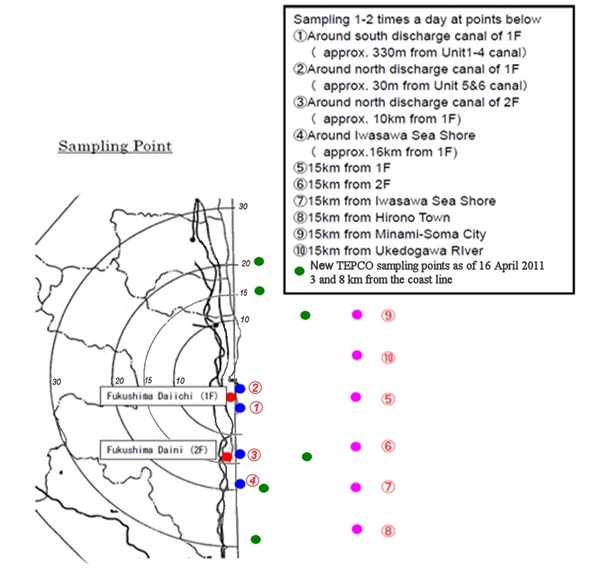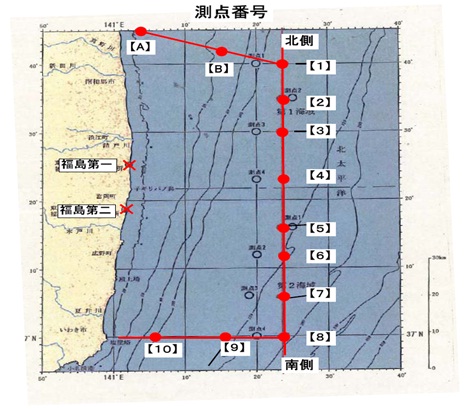→ Chronology of Updates:
2 June | 12-18 May | 4-11 May | 5 May | 3 May | 2 May | 28 April | 27 April | 26 April | 21 April | 20 April | 19 April | 18 April | 15 April | 14 April | 13 April | 12 April | 11 April | 10 April | 9 April | 8 April | 7 April | 6 April | 5 April | 4 April | 3 April | 2 April | 1 April | 31 March | 30 March | 29 March | 28 March | 27 March | 26 March | 25 March | 24 March | 23 March | 22 March | 21 March | 20 March | 19 March | 18 March | 17 March | 16 March | 15 March | 14 March | 13 March | 12 March | 11 March | Full Update
IAEA BRIEFING ON FUKUSHIMA NUCLEAR ACCIDENT (19 April 2011, 18.00 UTC)
Presentations:
→ Summary of Reactor Status
→ Fukushima Radiological Monitoring and Consequences
→ Fukushima Marine Environment Monitoring
→ Watch Video
On Tuesday, 19 April 2011, the IAEA provided the following information on the current status of nuclear safety in Japan:
1. Current Situation
Overall, the situation at the Fukushima Daiichi nuclear power plant remains very serious but there are early signs of recovery in some functions, such as electrical power and instrumentation.
On 17 April, the Ministry of Economy, Trade and Industry (METI) announced that TEPCO had issued a "Roadmap towards Restoration from the Accident at the Fukushima Daiichi Nuclear Power Station". The roadmap outlines 63 measures to be taken in two steps over a period of six to nine months.
Changes to Fukushima Daiichi Nuclear Power Plant Status
The IAEA receives information from a variety of official Japanese sources through the nation's national competent authority, the Nuclear and Industrial Safety Agency.
TEPCO has provided a plan to NISA for the transfer of highly contaminated water from the basement floor of the turbine building of Unit 2 to the Main Building of the Radioactive Waste Treatment Facilities in order to reduce the risk of this stagnant waste water being discharged to the environment.
On 17 and 18 April, an unmanned robot was used to conduct inspections of the Reactor Buildings in Units 1, 2 and 3.
As of 18 April, white "smoke" was still observed coming from Units 2, 3 and 4.
In Unit 1, fresh water is being continuously injected into the RPV through the feed-water line at an indicated flow rate of 6 m3/h using a temporary electric pump with off-site power. In Units 2 and 3, fresh water is being continuously injected through the fire extinguisher lines at an indicated rate of 7 m3/h using temporary electric pumps with off-site power.
RPV temperatures remain above cold shutdown conditions in all Units. In Unit 1 the temperature at the feed water nozzle of the RPV is 170 °C and at the bottom of the RPV is 115 °C. In Unit 2, the temperature at the feed water nozzle of the RPV is 142 °C. In Unit 3 the temperature at the feed water nozzle of the RPV is 100 °C and at the bottom of the RPV is 114 °C.
In Unit 1 Nitrogen gas is being injected into the containment vessel to reduce the possibility of hydrogen combustion within the containment vessel. The pressure in this containment vessel has stabilised. The pressure in the RPV is increasing. In Units 2 and 3 Reactor Pressure Vessel and Drywell pressures remain at atmospheric pressure.
On 18 April the concrete pump truck sprayed water into the Unit 3 spent fuel pool. On 17 April, approximately 140 tonnes of fresh water was pumped into the Unit 4 spent fuel pool.
There has been no change in the status in Units 5 and 6 or in Common Spent Fuel Storage Facility.
On 17 and 18 April, anti-scattering agent was sprayed over an additional 3100 m2 area near the Centralized Waste Treatment Facility.
2. Radiation Monitoring
On 18 April, deposition of I-131 was detected in 6 prefectures ranging from 2.3 to 65 Bq/m2. Deposition of Cs-137 was detected in 2 prefectures; the values reported were 4.7 and 14.8 Bq/m2.
Gamma dose rates are measured daily in all 47 prefectures. The values tend to decrease over time. For Fukushima, on 18 April a dose rate of 1.9 µSv/h was reported. In the Ibaraki prefecture, a gamma dose rate of 0.13 µSv/h was reported; in all other prefectures, reported gamma dose rates were below 0.1 µSv/h.
Dose rates are also reported specifically for the Eastern part of the Fukushima prefecture, for distances beyond 30 km from Fukushima-Daiichi. On 17 April, the values in this area ranged from 0.1 to 23 µSv/h.
MEXT has set up an additional monitoring programme in cooperation with local universities. For 18 April, measurements of the gamma dose rates were reported for 53 cities in 40 prefectures. In Fukushima City, a value of 0.38 µSv/h was observed; in 9 cities, gamma dose rates ranged from 0.13 to 0.17 µSv/h. For the other cities, gamma dose rates of less than 0.1 µSv/h were reported.
In drinking water, I-131 or Cs-137 is detectable at very low levels only in a few prefectures. As of 17 April, one restriction for infants related to I-131 (100 Bq/l) is in place in a small scale water supply in a village of the Fukushima prefecture.
On 18 April, the IAEA Team made measurements at 12 different locations in the Fukushima area at distances ranging from 13 to 43 km, South and Southwest from the Fukushima nuclear power plant. At these locations, the dose rates ranged from 0.25 to 6.8 µSv/h. At the same locations, results of beta-gamma contamination measurements ranged from 0.01 to 0.15 Megabecquerel/m2.
Analytical results related to food contamination were reported by the Japanese Ministry of Health, Labour and Welfare on 18 April, and covered a total of 23 samples taken on 8, 15, 17 and 18 April. Analytical results for all of the samples of various vegetables, shiitake mushrooms, leafy vegetables, fruit (strawberries), fish and unprocessed raw milk in eight prefectures (Chiba, Fukushima, Gunma, Hokkaido, Ibaraki, Niigata, Saitama and Yamagata) indicated that I-131, Cs-134 and/or Cs-137 were either not detected or were below the regulation values set by the Japanese authorities.
3. Marine Monitoring
TEPCO Monitoring Programme
TEPCO is conducting a programme for seawater (surface sampling) at a number of near-shore and off-shore monitoring locations following a directive from NISA, on 16 April TEPCO announced they will increase the number of sea sampling points from 10 to 16. A further four points will be added at 3 km from the coast and two points will be added at 8 km from the coast. The new sampling sites are indicated on the map below. (See Map 5: TEPCO Seawater Sampling Locations, new points indicated with green bullets).
On some days, two samples were collected at the same sampling point, a few hours apart and analysed separately.
Until 3 April a general decreasing trend in radioactivity was observed at the sampling points TEPCO 1 to TEPCO 4. After the discharge of contaminated water on 4 April, a temporary increase in radioactivity has been reported. Again since 5 April, general decreasing trend has been observed in the concentration of radionuclides in sea water for all TEPCO sampling points.
On 18 April new data for TEPCO sampling points have been reported (sampling date 15 April). Since 9 April the levels of I-131 and Cs-137 at the sampling points TEPCO number 5-10 are lower than those at the near-shore stations (below 0.5 kBq/l) and the levels of I-131 and Cs-137 at the sampling points TEPCO 1 - 4 are below 20 kBq/l. At all TEPCO sampling points since 9 April a decreasing trend has been observed.
MEXT Off-shore Monitoring Programme
The Japanese Ministry of Education, Culture, Sports, Science and Technology (MEXT) initiated the off-shore monitoring program on 23 March and subsequently 4 points were added to the off-shore sampling scheme. On 4 April, MEXT added two sampling points to the north and west of sampling point 1. These are referred to as points A and B. (See Map 6: MEXT Seawater Sampling Locations).
The results reported on 18 April (sampling date 15 April) showed that Cs-137 and I-131 were detected at MEXT 4, 6 and 8. The highest concentrations were recorded at MEXT 4 (below 200Bq/l for Cs-137 and about 160 Bq/l for I-131). At MEXT 6 and 8 sampling locations both Cs-137 and I-131 were reported at levels below about 40 Bq/l.
The results reported on 19 April (sampling date 17 April) showed that at the stations MEXT 5, 7 and 9, Cs-137 and I-131 are below 90 Bq/l.
Neither Cs-137 nor I-131 have been detected at MEXT A and B. (See Map 6: MEXT Seawater Sampling Locations).
Map 5: TEPCO Seawater Sampling Locations:

Map 6: MEXT Seawater Sampling Locations:

4. IAEA Activities
The mission of BWR expert to Japan provided the IAEA with a unique opportunity to communicate directly with the various stakeholders working to address challenges at both the Daiichi and Daini reactor sites. All organizations fully cooperated with the IAEA team and provided the team with a better understanding of event sequences, current challenges and future plans and priorities.
The IAEA team of BWR experts toured the Fukushima Daiichi site and the Emergency center. The team was also able to tour the Fukushima Daini site. At all facilities, the IAEA team noted a strong, positive attitude broadly displayed by the management, support and task implementation teams, even though the situation is not yet stabilized. Activities appeared to be well organized, efforts were thoroughly planned, and responsibilities well communicated.